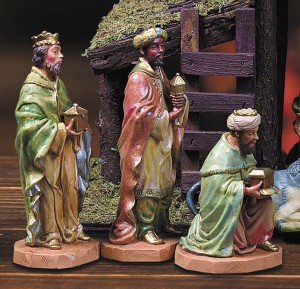The Nativity scene, also known as a Manger Scene, Crèche or Crib is one of the most enduring and endearing symbols of the Christmas season.
Inspired by a trip to the Holy Land, St. Francis of Assisi created the first known Nativity scene in 1223 using real animals and townspeople. As the living scene became popular through Europe, artists began to create small replicas made of wax, wood and ivory. While many were very simple, there were a small number made for the royalty and noblemen of the 15th century that featured characters adorned in elaborate fabric, jewels and gold.
The Nativity, as a part of the observation of Christmas in America, emerged in the early part of the 19th Century and was in full swing by the Victorian era of the late 1800s. Originally they consisted of Mary, Joseph and the baby Jesus, with the Christ child being set aside and not added to the set up until Christmas morning. Gradually through the years the Three Wise Men, angels, shepherds, farm animals and even buildings were added. The most common and reasonably priced sets from the 1800s will be die-cut cardboard with beautiful multi-colored lithography and were imported from Italy. For those collectors with deeper pockets there are high-relief soapstone sets from France and finely crafted wooden scenes made in Germany.
The quaint charm of American Folk Art nativities from the early 1900s are finding a growing audience among collectors. Hand crafted from readily available materials, they are difficult to find as they are normally kept within the family of the artist and handed down from generation to generation. Of particular interest are pieces designed for the traditional Pennsylvania Dutch “Putz.” The figures in these sets will be made of tin and clay.
By the middle of the 20th century, Nativities were mass-produced from plastic, plaster, and glitter coated cardboard. These are easy to find and easy on the pocketbook, falling in the $15-$25 range. Celluloid sets abound on eBay and Etsy and are modestly priced in the $30-$40 range. Slightly more difficult to come by are chalkware sets that, if they are intact, will have from 9-11 pieces and will run in the $90-$140 range.
One of the most popular of the “modern” Nativities are the Hummel figures, released in 1947. Prices will vary depending on the year of issue, ranging from $100-$150 for the basic three piece set to as much as $1,200 for the full 16 piece set.
As travel to the Holy Land became popular in the last quarter of the 20th century, tourists to that part of the world often returned with beautiful hand carved Nativities made from olive wood. The shop of world renowned Christian artist Jeries Facouseh, located in Bethlehem, produced many of these highly detailed works. These have become highly collectible and are increasing in value. But note, there are mass-produced Nativities that mimic these that are worth a fraction of the value. Take a few extra minutes to look for the artist markings before you buy.
Understandably, Nativity sets are commonly set up far from the reach of small children. If you have little ones in your home, Fisher Price makes a great “Little People Nativity” that will allow the kids to enjoy the Nativity, without destroying your collection! Until next time . . . Linda
Linda Kennett may be reached at 317-258-7835 or lkennett@indy.rr.com



